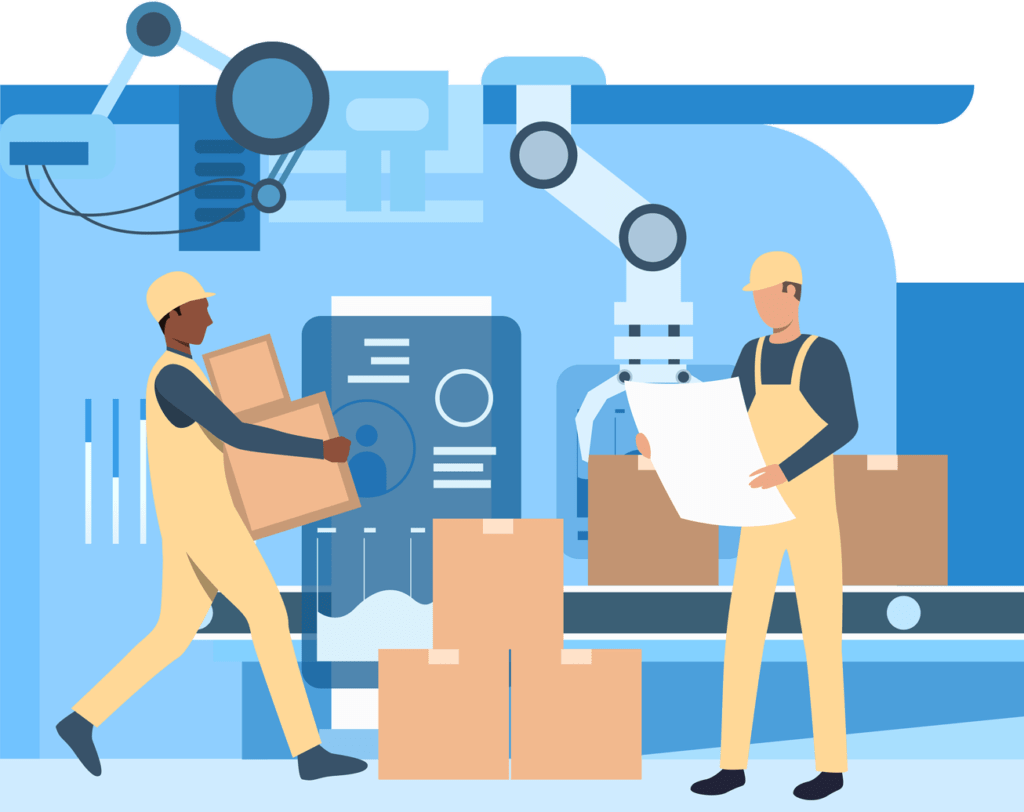
Empowering Manufacturing Excellence with Data-Driven Solutions
Empower your business with innovative technologies that tackle today’s industry challenges and deliver transformative results
Manufacturing is evolving with the integration of advanced technologies like IoT, AI, and cloud platforms. Data-driven solutions are enabling manufacturers to address challenges, optimize processes, and achieve scalability and efficiency.
Key Challenges in Manufacturing
-
Data Silos and Fragmentation hinder seamless data flow and collaboration.
-
Supply Chain Complexity impacts inventory management and decision-making.
-
Predictive Maintenance to avoid Equipment failures leading to costly downtime
How Tulapai Empowers the Industry
-
Unified Data Integration: Consolidates data across ERP, IoT, and CRM systems for seamless visibility.
-
Real-Time Analytics: Enables dynamic monitoring of supply chains, operations, and inventory.
-
Predictive Insights: Uses AI/ML models to forecast demand, detect anomalies, and prevent failures.

Empowering Industries with Smarter Data Solutions
Use Cases We Address
We tackle the complexities of data management, enabling seamless insights, optimized operations, and better decision-making to drive growth and operational efficiency
Business Impact
Manufacturers who adopt our solutions experience
1
Operational Excellence
Our solutions drive operational efficiency by automating workflows, reducing downtime, and ensuring seamless integration of data across systems, leading to faster and more accurate decision-making
2
Cost Savings and Scalability
Cloud-based platforms and advanced analytics help manufacturers optimize resource utilization, reduce waste, and achieve cost efficiency while scaling operations to meet growing demands without additional infrastructure costs
3
Supply Chain Resilience
Real-time visibility into supply chains enables proactive risk management, improved coordination with suppliers, and faster response times, ensuring uninterrupted operations and timely deliveries
4
Sustainability and Innovation
Our data-driven approach minimizes energy usage, reduces material wastage, and supports sustainability goals while fostering innovation through predictive insights and advanced technology adoption
You ask, we answer
Ready to move? Get a quote now!
Streamlining Fragmented Data Ecosystems
Data Silos and Fragmentation
Data silos hinder operational efficiency by preventing seamless data sharing across ERP, MES, IoT, and CRM systems. This fragmentation leads to inefficiencies, delayed decision-making, and missed opportunities for optimization.
Challenges
- Disconnected Systems: Limit visibility and create silos, making holistic oversight difficult.
- Redundant Processing: Causes inefficiencies and delays, wasting resources and time.
- Compliance Issues: Difficult to achieve traceability, leading to regulatory risks.
- Scalability Limits: Legacy systems struggle with data growth, reducing future-readiness.
- Poor Interoperability: Platforms and systems lack integration, requiring manual workarounds.

Our Solutions

Cloud Data Platforms: Integrate siloed data into unified platforms like Snowflake for seamless access.
ETL Pipelines: Automate data extraction, transformation, and harmonization using tools like Fivetran and Matillion.
Real-Time Data Sharing: Enable cross-department collaboration and rapid insight generation with scalable data-sharing frameworks.
Data Governance Policies: Implement frameworks to ensure data accuracy, accessibility, and security.
Custom APIs: Develop APIs to enable seamless system integration and reduce manual effort.
The Impact We Create
Enhanced Efficiency
Real-time insights improve decision-making and collaboration, reducing delays and enabling faster response times across departments
Supply Chain Resilience
Unified data boosts supply chain visibility and responsiveness, ensuring smooth operations even during disruptions
Cost Savings
Streamlined data processes reduce redundancies, cutting operational expenses and improving resource allocation for higher ROI
Ready to move? Get a quote now!
Improving Supply Chain Coordination
Supply Chain Visibility
Supply chain visibility is critical for tracking materials, inventory, and deliveries in real time. Fragmented data systems often lead to delays, inefficiencies, and risks that disrupt operations and customer satisfaction.
Challenges
- Real-Time Data Gaps: Lack of access across the supply chain disrupts timely decision-making.
- Collaboration Barriers: Silos hinder stakeholder coordination, leading to missed opportunities.
- Disruption Risks: Unpredictable issues cause inefficiencies, increasing operational vulnerabilities.
- Supplier Visibility: Multi-tier networks lack transparency, reducing accountability.
- Logistics Issues: Disconnected systems impact management, increasing delivery delays.
Our Solutions

IoT Integration: Use IoT sensors to monitor shipments, inventory, and production in real-time.
Advanced Analytics: Leverage AI to predict risks and optimize supply chain performance.
Collaborative Platforms: Enable seamless data sharing between stakeholders for synchronized operations and better coordination.
Digital Twin Technology: Create virtual replicas of supply chains for scenario analysis and optimization.
Predictive Risk Management: Use AI to forecast potential disruptions and devise proactive strategies.
The Impact We Create
Reduced Delays
Improved tracking eliminates bottlenecks and ensures on-time deliveries, enhancing customer trust and operational reliability
Cost Optimization
Real-time insights minimize inventory holding costs and waste, boosting profitability and reducing excess stock.
Enhanced Customer Satisfaction
Timely deliveries build trust and loyalty, improving competitive edge and long-term client relationships
Optimizing Equipment Utilization with Advanced Maintenance
OEE and Predictive Maintenance
Operational Equipment Effectiveness (OEE) and predictive maintenance are vital for minimizing downtime and maximizing productivity. Traditional reactive approaches often result in costly delays and inefficiencies.
Challenges
- Reactive Downtime: Leads to delays and high repair costs, hurting productivity.
- Performance Blind Spots: Limited visibility hampers decisions, risking production bottlenecks.
- Inefficient Maintenance: Wastes resources and raises costs, lowering ROI.
- Failure Predictions: Lack of integrated historical data increases the risk of breakdowns.
- Spare Parts Costs: Excessive inventory increases expenses, tying up capital unnecessarily.
Our Solutions

IoT Sensors: Capture real-time data on equipment health and performance.
Predictive Analytics: Use AI/ML models to forecast equipment failures and plan maintenance proactively.
Visualization Tools: Create dashboards for monitoring OEE and maintenance schedules to improve planning.
Root Cause Analysis: Integrate machine data to identify and resolve recurring issues.
Automated Workflows: Streamline maintenance planning with triggers for real-time alerts and repair schedules.
The Impact We Create
Downtime Reduction
Proactive maintenance minimizes disruptions and extends equipment lifespan, ensuring production efficiency
Cost Efficiency
Reduced repair costs and improved resource allocation lead to streamlined operations and sustainable savings
Productivity Gains
Optimized equipment utilization enhances production outputs, reducing waste and improving profitability
Aligning Forecast Accuracy with Material Planning Efficiency
Demand Forecasting & MRP
Demand forecasting and Material Resource Planning (MRP) are pivotal for aligning production schedules with fluctuating customer demands. These practices ensure inventory optimization, cost efficiency, and operational continuity. However, fragmented systems and inaccurate forecasts often disrupt these processes, leading to overstocking, stockouts, and missed opportunities.
Challenges
- Fluctuating Demand: Inaccurate planning leads to overproduction or stockouts, impacting profitability.
- Fragmented Data: Lack of integration across ERP, CRM, and supply chain systems hinders effective forecasting.
- Inefficient Resource Utilization: Results in idle equipment or overburdened production lines, lowering efficiency.
- Limited External Insights: Market trends and seasonality are poorly accounted for, reducing forecast accuracy.
- Supply Chain Disruptions: Poor synchronization with suppliers and distributors creates bottlenecks and delays.
Our Solutions

- Unified Data Integration: Centralize data from ERP, CRM, and supply chain systems for comprehensive visibility and real-time forecasting.
- Advanced Analytics: Use AI/ML models to predict demand patterns based on historical data and external variables.
- Real-Time Inventory Updates: Implement dynamic inventory tracking to align stock levels with current demand.
- Scenario Analysis Tools: Simulate market conditions to optimize production schedules and resource allocation.
- Collaborative Forecasting: Share real-time forecasts with suppliers and distributors for improved synchronization.
The Impact We Create
Improved Production Efficiency
Align production schedules with accurate demand forecasts to reduce waste, optimize output, and minimize delays
Cost Optimization
Avoid overproduction and stockouts, reducing inventory holding costs and improving financial efficiency
Enhanced Customer Satisfaction
Consistent product availability meets customer expectations, boosting trust and loyalty
Enhancing Quality Assurance Through Automation
Quality Control
Ensuring consistent product quality requires advanced data-driven methods to detect and resolve defects in real time. Manual inspections and siloed data often result in inefficiencies and compliance risks.
Challenges
- Missed Defects: Manual inspections lack real-time analysis, reducing product quality.
- Fragmented Data: Restricts tracking and proactive action, increasing defect risks.
- Regulatory Delays: Compliance processes are resource-heavy, slowing operations.
- Material Variability: Affects quality and consistency, leading to rework and waste.
- Slow Feedback: Delayed loops hinder process improvement, impacting efficiency.
Our Solutions

AI-Powered Vision Systems: Automate defect detection and quality monitoring with image recognition.
Centralized Quality Data: Integrate production and testing data for predictive analytics and faster insights.
Automated Reporting: Generate real-time dashboards for quality trends and compliance metrics to streamline audits.
Machine Learning Models: Predict quality issues using historical data to address root causes.
Supplier Quality Management: Implement tools to track and ensure raw material compliance with quality standards.
The Impact We Create
Improved Product Quality
Enhanced defect detection ensures adherence to quality standards, reducing recalls and boosting customer confidence
Waste Reduction
Proactive root cause analysis minimizes defects and material wastage, saving costs and improving efficiency
Regulatory Compliance
Automated reporting streamlines audits and adherence to standards, ensuring faster processes and better results
Adopting Scalable and Cost-Effective Solutions
Scalability and Cost Efficiency
Scalability and cost efficiency are crucial for manufacturers managing growing data volumes and operational demands. Legacy systems often struggle to scale effectively without incurring high infrastructure costs.
Challenges
- Infrastructure Costs: Rising expenses hinder scalability, restricting growth potential.
- Resource Waste: Inefficient utilization raises expenses, reducing profitability.
- Data Overload: Legacy systems struggle with IoT data, leading to bottlenecks.
- Integration Limits: Facilities lack optimization potential, causing inefficiencies.
- Energy Consumption: High costs impact sustainability, lowering operational efficiency.

Our Solutions

Cloud Data Platforms: Centralize data storage and processing to support elastic scalability.
Advanced Analytics: Implement AI/ML models to optimize processes and resource allocation.
Cost-Tiered Storage: Use Snowflake’s storage options to manage historical data affordably.
Dynamic Resource Allocation: Allocate resources based on real-time production demands.
Energy Efficiency Tools: Monitor and optimize energy usage across facilities to reduce costs.
The Impact We Create
Lower Infrastructure Costs
Cloud-native platforms eliminate the need for expensive hardware upgrades and maintenance
Operational Agility
Easily scale production, supply chain, and analytics capabilities to meet growing demands
Improved Resource Utilization
Dynamically allocate resources to minimize waste and optimize efficiency
You ask, we answer
FAQ
Tulapai consolidates data from disconnected systems like ERP, MES, and IoT devices into a unified platform, enabling seamless integration and real-time insights for better decision-making.
Predictive maintenance minimizes downtime, reduces repair costs, and extends equipment lifespan by proactively identifying potential failures using IoT sensors and AI-driven analytics.
Tulapai leverages cloud-native platforms like Snowflake to provide elastic scaling, allowing manufacturers to handle increasing data volumes and operational complexities without high infrastructure costs.
By integrating IoT sensors and advanced analytics, manufacturers gain real-time insights into shipments, inventory, and supplier performance, reducing delays and optimizing supply chain operations.
Yes, our solutions use predictive analytics and automated reporting tools to ensure adherence to regulatory standards, minimizing defects and enhancing audit efficiency.
Tulapai combines industry expertise with advanced technologies to deliver tailored, scalable solutions that address manufacturing challenges, drive innovation, and ensure measurable business impact.
